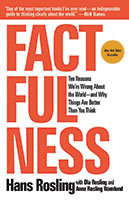Hans Rosling discovered that whether it’s world leaders or everyone else, we all share a tendency to overdramatize the state of the planet
*****
How well do you know what is going on in the world? Let’s put it to a test. Without consulting the internet or someone else, give these questions your best shot:
- How did the number of deaths per year from natural disasters change over the last hundred years?
a. More than doubled
b. Remained about the same
c. Decreased to less than half - In the last 20 years, the proportion of the world population living in extreme poverty has…
a. Almost doubled
b. Remained more or less the same
c. Almost halved - Worldwide, 30-year-old men have spent 10 years in school, on average. How many years have women of the same age spent in school?
a. 3 years
b. 6 years
c. 9 years - In the 1990s, bald eagles, giant pandas, and snow leopards were all listed as endangered. How many of these three species are more critically endangered today?
a. Two of them
b. One of them
c. None of them - How many of the world’s 1-year-old children today have been vaccinated against some disease?
a. 20 percent
b. 50 percent
c. 80 percent
Worse than chimps
The right answers are all C. How many did you get correct? If you didn’t get a great score, you are in good company. These questions come from Hans Rosling, the author of the fascinating book Factfulness. He made a quiz with 13 questions total, about different aspects of the state of the world – how we are doing as a planet. He asked about things like access to electricity, world population, and where people live in the world.
Then he gave the quiz to nearly 12,000 people in 14 countries. On average they got just 2 of the 13 right. That’s remarkable when you consider if people filled in answers at random, they would have done better, getting a third of the three-answer questions right (averaging between 3 and 4 right). More remarkably, out of the 12,000 quizzed nobody got them all right. And just one person got 11 out of 12 right.
Why?
Is the problem that people aren’t educated enough? Rosling first thought this may be the case, but then he tested the most educated among us – medical students, teachers, scientists, journalists, business leaders, among others – and discovered that the majority still got most answers wrong and some did worse than the general public.
Then Rosling realized that not only are people wrong about their understanding of the world, they are systematically wrong – they do worse than if they had no knowledge at all. As Rosling explained, if he went to the zoo to give the same quiz to chimpanzees, “the chimps, by picking randomly, would do consistently better than the well-educated but deluded human beings who take my tests.”
Not only is the public consistently wrong, but their errors skewed in one direction – participants consistently underestimated the true state of the world:
“Every group of people I ask thinks the world is more frightening, more violent, and more hopeless – in short, more dramatic – than it really is.”
Why do we underestimate the good so badly?
Since the mid 1990’s, Rosling devoted much of his time to exploring and explaining why we can be so wrong about rather basic facts about the world.
At first, he thought that people’s knowledge simply had to be updated and upgraded – they just needed to get educated. So that is what he set out to do – Rosling developed some amazing teaching tools and brought them to TED talks around the world, in addition to board rooms, banks, and even the US State Department. He was excited to show everyone how the world had changed for the good. But it didn’t take long and his enthusiasm waned.
“The ignorance we kept on finding was not just an upgrade problem. It couldn’t be fixed simply by providing clearer data animations or better teaching tools.”
It was one gathering in particular that convinced him. He was presenting to thousands of the most influential people of the world at the 2015 World Economic Forum (alongside Bill and Melinda Gates). His listeners included heads of state, heads of UN organizations, leaders of multinational companies, and famous journalists. He asked them just three questions – about the true state of poverty, population growth, and vaccination rates in the world. Although 61 percent answered the question about poverty correctly, when it came to population growth and vaccination, the crowd once again did worse than chimps.
That is when things crystalized for Rosling. He saw that the reason people were misperceiving the world was because they had a
faulty worldview.
“People constantly and intuitively refer to their worldview when thinking, guessing, or learning about the world. So if your worldview is wrong, then you will systematically make wrong guesses.”
But he was also quick to explain that this isn’t the fault of media or fake news. Rather, he believes that it is inbuilt, and comes from how our brains have a tendency to “overdramatize” things.
 Look at the two lines on this page. Which is longer? If you’ve seen this trick before you know that they are the same length. But even with that knowledge, they still look different, don’t they? Despite what we know we can still misperceive.
Look at the two lines on this page. Which is longer? If you’ve seen this trick before you know that they are the same length. But even with that knowledge, they still look different, don’t they? Despite what we know we can still misperceive.
Rosling thinks something similar is going on with how our brains analyze the world – even when we know better, we can still fall for the “more frightening, more violent, and more hopeless – in short, more dramatic” misperception of things.
Rosling proceeded to devote the rest of his life to this curiosity, and his book Factfulness flowed from this work.
“Start to practice it, and you will be able to replace your overdramatic worldview with a worldview based on facts. You will be able to get the world right without learning it by heart.”
Through the rest of the book, he trains readers to be aware of the various ways we systematically misperceive the world because of our “gap instinct, negativity instinct, …fear instinct” and more. Most of us would do well to learn about these instincts, which have us consistently underestimating the good around us.
- The Gap Instinct: Rosling calls it “that irresistible temptation we have to divide all kinds of things into two distinct and often conflicting groups, with an imagined gap – a huge chasm – in between.” For example, many believe that the developing world’s infant mortality rates will always remain much higher than ours. But whereas the global child mortality rate was 27% in 1950 (that’s the percentage of children who didn’t live to reach the end of puberty), now the very worst child mortality rate in the world is about half that, at 15% in Niger. Globally it is down to 4.3 percent (as of 2022). When it came to child mortality there was once a divide between the West and rest, but today that divide persists in people’s minds, and not in reality.
- The Fear Instinct: We have an inbuilt focus on the frightening, which makes it hard for us to see how things may be improving. So, when a hurricane hits, we might hear about how climate change is going to cause more and more of these, and what we don’t hear is how many fewer people died than in decades past. As they say, if it bleeds, it leads, so we hear lots about what is scary but little of what is reassuring and encouraging.
- The Negativity Instinct: Rosling shared that when people in 30 countries were asked, is the world getting better, staying the same, or getting worse, more than 50% picked “getting worse” no matter what country they came from (roughly 75% of Canadians said “getting worse”). Yet there are some huge improvements happening, including that the number of people living in extreme poverty – surviving on less than $2/day – has dropped from 50% of the world in 1966 to just 9% in 2017.
If our decision makers in government and the Church had read this book before making decisions about Covid restrictions, we would all have benefitted. Then the fears that emanated from Covid and hospitalization projections would have been put into a much more reasonable context.
But the implications go well beyond pandemics. I don’t think the world is prepared for the future we will face with half as many children being born per woman as just 50 years ago. Most people, including many in the Church, wrongly assume that the straight line of population growth will keep extending upwards. And they see that as a threat, with an ever-expanding population exceeding the planet’s ability to feed them all. But, as mentioned, even as population grows, fewer people are in extreme poverty. And just as a child won’t keep growing at the same rate through life, we’re seeing the birth rate take a sharp decline. The more informed worry is not overpopulation but a coming population collapse.
Which worldview?
As helpful as Rosling’s book is, he had his own misperception. He eventually recognized the importance of worldview, but he did so from a evolutionary vantage point. “The human brain is a product of millions of years of evolution,” he wrote, when answering why so many people would be consistently wrong. “We are hard-wired with instincts that helped our ancestors to survive in small groups of hunters and gatherers.”
The beginning of wisdom
Christians have a better explanation. That people would consistently overlook the many blessings around them and focus instead on troubles, many of them even imagined, is what sinful people do.
A look through the Old Testament shows that God’s people are not immune to this ingratitude. But we are blessed to also have the answer. To fight negativity, fear, and ingratitude, we need only remember who God is. He isn’t just the God of the universe – He is our loving Father, the One Who knows who we are and has a perfect plan for our lives and for the future of the Church and the world.
When we take this to heart, we can begin to get a glimpse into how this will change how we look at the world. Is it a scary place? Do we have reason to fear the future? Are things going to hell in a handbasket? Not at all. Those conclusions flow from a godless worldview, and perhaps also the worldview from some other major religions (like Islam), where their god is powerful but not a loving father. And they sure aren’t consistent with reality.
By God’s grace, the world has been becoming a safer, healthier, more abundant place to live (contrary to what we would think if we only got our information from the news). But even if we face another war or pandemic, we can take comfort knowing that God “still upholds heaven and earth and all creatures, and so governs them that leaf and blade, rain and drought, fruitful and barren years, food and drink, health and sickness, riches and poverty, indeed, all things, come to us not by chance but by his fatherly hand” (Lord’s Day 10, Heidelberg Catechism).













